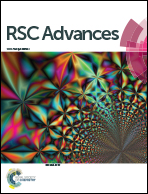Benefits of tubular morphologies on electron transfer properties in CNT/TiNT nanohybrid photocatalyst for enhanced H2 production
Abstract
In order to study the influence of one dimensional tubular structures for effective electron and hole transportation onto the surface of a photocatalyst leading to efficient solar photocatalytic hydrogen production, functionalized carbon nanotube (FCNT)/TiO2 nanotube nanohybrids were prepared. TiO2 nanotubes (TiNTs) were prepared by hydrothermal method. A series of novel functionalized carbon nanotube/TiO2 nanotube nanohybrids (CTT) were prepared for different wt% (1–20) of FCNTs by wet impregnation method to extend absorption in the visible region and also to retard the electron–hole pair recombination and thereby to enhance the H2 production capability under solar light irradiation. The functionalized carbon nanotube/TiO2 nanotube nanohybrids (CTT) were characterized with XRD, TEM, DRS-UV-Vis, Raman spectroscopy and XPS for crystal structure, morphology, optical properties and chemical composition. Addition of FCNTs to the TiNTs in CTT nanohybrids extended the absorption to the visible region. Relative electron–hole recombination times were measured with photoluminescence spectra. The highest H2 generation of 29 904 μmol g−1 was observed after 4 h under optimal conditions due to better separation of electron–hole pairs and electron conducting properties.



 Please wait while we load your content...
Please wait while we load your content...